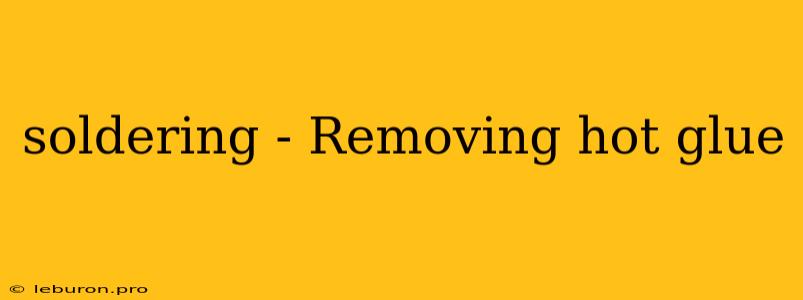Soldering is a fundamental skill in electronics, but sometimes it can be a challenge to remove unwanted components or rework soldered joints. One common obstacle is the presence of hot glue, which can trap components or create a sticky mess around the solder joint. This can make soldering and desoldering difficult and frustrating. Fortunately, there are effective methods for removing hot glue before soldering, allowing you to work with your components easily and efficiently.
Removing Hot Glue Before Soldering
Hot glue, while versatile and useful in various applications, can be a nuisance when working with electronics. Its tenacious hold can make removing components or accessing solder joints a difficult task. This is particularly problematic in situations where you need to rework a soldering job or replace a faulty component. Before you can tackle any soldering, it's crucial to remove the hot glue.
Methods for Removing Hot Glue
There are several methods for removing hot glue, each with its own advantages and disadvantages. You can choose the method that best suits your needs and the specific situation you are dealing with.
1. Heat Gun: This is the most common and generally effective method. A heat gun is a versatile tool that can be used to soften and loosen hot glue, allowing you to remove it with ease.
**a. ** Using a Heat Gun:
- Preparation: Ensure the area around the hot glue is free of flammable materials. Protect your workspace and yourself with appropriate safety gear, including gloves and eye protection.
- Application: Direct the hot air from the heat gun onto the hot glue, focusing on the area you need to remove. Be careful not to overheat the surrounding components or the PCB.
- Removal: Once the glue is sufficiently softened, use a scraper, putty knife, or tweezers to carefully pry it away. Work slowly and patiently to avoid damaging the surrounding circuitry.
**2. ** Hot Plate: A hot plate can provide a more controlled and even heating method compared to a heat gun.
**a. ** Using a Hot Plate:
- Preparation: Place the component or board with the hot glue on the hot plate. Adjust the heat setting to a low to medium temperature.
- Heating: Allow the hot glue to soften gradually on the hot plate.
- Removal: Use a scraper, putty knife, or tweezers to gently remove the softened glue. Be careful not to damage the component or board.
**3. ** Isopropyl Alcohol: Isopropyl alcohol is a safe and effective solution for dissolving hot glue.
**a. ** Using Isopropyl Alcohol:
- Application: Soak a cotton swab or cloth in isopropyl alcohol and apply it to the hot glue.
- Waiting: Allow the alcohol to penetrate and soften the glue.
- Removal: Once the glue is softened, use a scraper or tweezers to gently peel it away.
**4. ** Mechanical Removal: In some cases, you can use a sharp object, such as a blade or a scalpel, to carefully cut or scrape away the hot glue.
**a. ** Using a Blade or Scalpel:
- Caution: This method requires extreme care to avoid damaging the surrounding components. Use the blade or scalpel at a shallow angle and apply gentle pressure.
**5. ** Freezing Method: Freezing the hot glue can make it brittle, allowing you to easily break it off.
**a. ** Using Freezing:
- Preparation: Place the component or board with the hot glue in a freezer for several hours.
- Removal: Once frozen, you can easily break off the hot glue with a scraper or tweezers.
**6. ** Commercial Hot Glue Removers: Several commercially available hot glue removers can be used to soften and loosen the glue. These removers are typically sprayed or applied directly to the glue.
**a. ** Using Commercial Removers:
- Follow Manufacturer Instructions: Always refer to the manufacturer's instructions for the specific product you are using. Pay attention to safety precautions and proper application techniques.
Tips for Effective Hot Glue Removal:
- Safety First: Always wear safety glasses and gloves to protect your eyes and hands.
- Patience: Removing hot glue takes time and patience. Work carefully and avoid using excessive force.
- Cleanliness: After removing the hot glue, clean the area thoroughly with a suitable solvent to remove any residue.
Soldering After Removing Hot Glue
Once you have successfully removed the hot glue, you can proceed with soldering. You will want to ensure that the area around the solder joint is clean and free of any glue residue.
Here are some additional tips for soldering after removing hot glue:
- Flux: Use a good quality flux to improve the soldering process and create a strong, reliable connection.
- Heat: Apply heat to the solder joint for a short duration.
- Solder: Use the appropriate solder for the application and ensure you have a good solder joint with a shiny, smooth finish.
Important Considerations:
- Heat Sensitivity: Be aware of the heat sensitivity of the components you are working with. Some components can be damaged by excessive heat.
- Component Damage: Take care not to damage the components or the PCB during the hot glue removal process.
Conclusion
Removing hot glue before soldering is an essential step in many electronics projects. By using the right tools and techniques, you can safely and effectively remove hot glue without damaging the components or the PCB. This will allow you to solder your connections properly and ensure your electronics project functions reliably.
